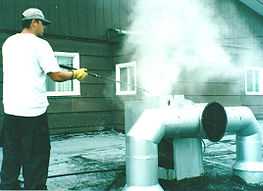Grease duct
A grease duct is a duct that is specifically designed to vent grease-laden vapors from commercial cooking equipment such as stoves, pizza ovens, deep fryers and woks to the outside of a building or mobile food preparation trailer. Grease ducts are regulated both in terms of their construction and maintenance, forming part of the building's passive fire protection system. Even the cleaning schedule is typically dictated by the fire code and evidence of compliance must be kept on file by the owner.
Special hazard
-

Kitchen exhaust hood interior view, before and after cleaning.
-

Rooftop fan on top of grease duct being cleaned in order to remove congealed grease.
-

Top view of kitchen exhaust fan assembly on top of a grease duct - before and after cleaning.
-

Bucket of kitchen exhaust grease after removal from commercial restaurant grease duct.
The grease laden vapors are hot, to begin with. As the vapors cool down, the grease settles on colder items. It is thus important for occupational safety and health as well as compliance with local fire codes to vent such vapors outside the kitchen and outside the building where the kitchen is located.
Grease, of course, is not only slippery, but also highly flammable. In fact, it qualifies as a hydrocarbon due to its inherent chemistry. Regardless of what state it is in, vapor, liquid or solid, it ignites easily and burns very rapidly, necessitating special provisions to accomplish a fire-resistance rating based on an internal grease fire as well as an external fire. Special provisions also include the necessity for proof that any adjacent firestop must be compatible with the grease duct system.
Requirements
In North America, grease ducts must be in compliance with NFPA 96 as well as the local building codes and fire codes. Cleaning takes place typically every 3 months, 6 months, or annually, depending on the nature of the appliances below the hood. For instance, woks require quarterly grease duct cleaning, whereas normal stoves may necessitate the grease duct to be cleaned only every 6 months. Compliance must be proven through certificates issued by the cleaning and maintenance contractors. Purpose-designed fire suppression systems inside the hoods must also be routinely maintained. Proper cleaning must be enabled through the use of approved, fire-resistant access panels. Grease ducts should be kept as short as possible to minimize grease build-up.
Systems
A proprietary duct system that has its own inherent fire-resistance rating can be used, or a metallic duct, either field fabricated or UL certified factory-built designs. Field fabricated is typically made from 16 gauge carbon steel, all welded, per local codes, which is then externally treated with fireproofing. Factory-built designs are UL tested to the UL 1978 test standard and are made from lighter gauge stainless steel and offered in single wall and multiple double wall insulated designs. Typical materials used for fireproofing field fabricated designs are:
- ceramic fibres
- rockwool
- calcium silicate
- vermiculite boards pressed and bonded with sodium silicate
- intumescents
- endothermic materials, sometimes on their own, sometimes in combination with ceramic fibre
Trade jurisdiction
In North American unionised construction sites, metallic ducts are typically installed by the sheet metal trade, whereas external wraps are usually installed by the insulators. Inherently fire-resistant systems are likewise installed by the sheet metal trade.
See also
- Passive fire protection
- Duct (HVAC)
- Pressurisation ductwork
- Smoke exhaust ductwork
- Circuit integrity
- Kitchen exhaust cleaning
- Extractor hood
External links
| Wikimedia Commons has media related to Kitchen Exhausts. |
- UL treatise on wrapping systems
- NFPA 96: Standard for Ventilation Control and Fire Protection of Commercial Cooking Operations